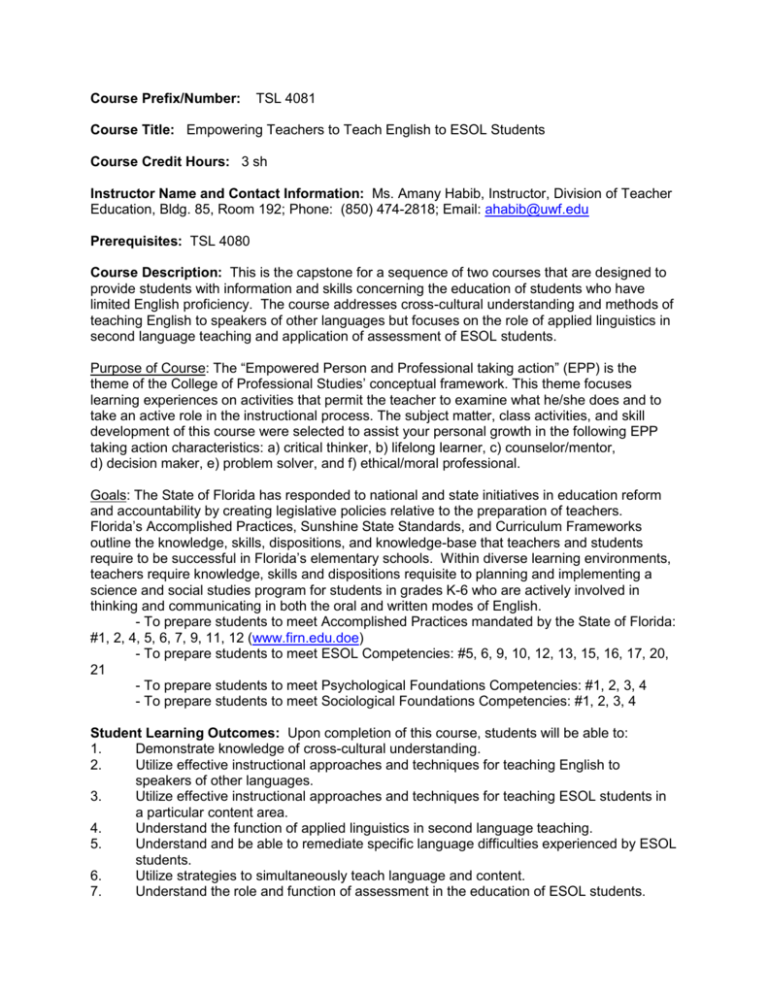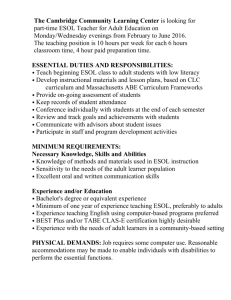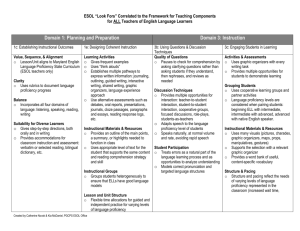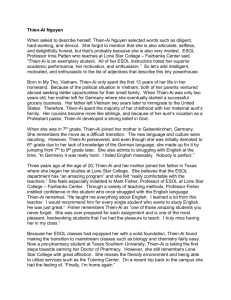Course Prefix/Number: TSL 4081
advertisement

Course Prefix/Number: TSL 4081 Course Title: Empowering Teachers to Teach English to ESOL Students Course Credit Hours: 3 sh Instructor Name and Contact Information: Ms. Amany Habib, Instructor, Division of Teacher Education, Bldg. 85, Room 192; Phone: (850) 474-2818; Email: ahabib@uwf.edu Prerequisites: TSL 4080 Course Description: This is the capstone for a sequence of two courses that are designed to provide students with information and skills concerning the education of students who have limited English proficiency. The course addresses cross-cultural understanding and methods of teaching English to speakers of other languages but focuses on the role of applied linguistics in second language teaching and application of assessment of ESOL students. Purpose of Course: The “Empowered Person and Professional taking action” (EPP) is the theme of the College of Professional Studies’ conceptual framework. This theme focuses learning experiences on activities that permit the teacher to examine what he/she does and to take an active role in the instructional process. The subject matter, class activities, and skill development of this course were selected to assist your personal growth in the following EPP taking action characteristics: a) critical thinker, b) lifelong learner, c) counselor/mentor, d) decision maker, e) problem solver, and f) ethical/moral professional. Goals: The State of Florida has responded to national and state initiatives in education reform and accountability by creating legislative policies relative to the preparation of teachers. Florida’s Accomplished Practices, Sunshine State Standards, and Curriculum Frameworks outline the knowledge, skills, dispositions, and knowledge-base that teachers and students require to be successful in Florida’s elementary schools. Within diverse learning environments, teachers require knowledge, skills and dispositions requisite to planning and implementing a science and social studies program for students in grades K-6 who are actively involved in thinking and communicating in both the oral and written modes of English. - To prepare students to meet Accomplished Practices mandated by the State of Florida: #1, 2, 4, 5, 6, 7, 9, 11, 12 (www.firn.edu.doe) - To prepare students to meet ESOL Competencies: #5, 6, 9, 10, 12, 13, 15, 16, 17, 20, 21 - To prepare students to meet Psychological Foundations Competencies: #1, 2, 3, 4 - To prepare students to meet Sociological Foundations Competencies: #1, 2, 3, 4 Student Learning Outcomes: Upon completion of this course, students will be able to: 1. Demonstrate knowledge of cross-cultural understanding. 2. Utilize effective instructional approaches and techniques for teaching English to speakers of other languages. 3. Utilize effective instructional approaches and techniques for teaching ESOL students in a particular content area. 4. Understand the function of applied linguistics in second language teaching. 5. Understand and be able to remediate specific language difficulties experienced by ESOL students. 6. Utilize strategies to simultaneously teach language and content. 7. Understand the role and function of assessment in the education of ESOL students. 8. Identify types of tests and select those appropriate for language minority students and for the particular goals of testing these students. Topics Covered: Introduction/Explanation of Requirements and Expectations Cross-Cultural Understanding and Multi-Cultural Perspectives Instructional Approaches and Techniques Applied Linguistics in Second Language Teaching Simultaneously Teaching Language and Content The Role and Function of Assessment Selecting and Administering Tests Appropriate for ESOL Students Alternative Assessment for ESOL Students Variety in Instructional Methods and Alternative Instructional Methods for ESOL Students Required texts: Ovando, C., Collier, V., Combs, M. (2003). Bilingual and ESL Classrooms: Teaching in Multicultural Contexts (3rd ed.). Boston, MA: McGraw-Hill. Recommended texts: Empowering ESOL Teachers, Teach Language Learning, Selected portions of Parts I, II & III, Tallahassee, FL: Florida Department of Education. Florida Department of Education (1999). Language arts through ESOL: A companion to the Sunshine State Standards for language arts. Tallahassee, FL: FLDOE. Websites: International Reading Association: www.reading.org International TESOL organization: www.tesol.edu Florida State TESOL organization: www.sunshine-tesol.org Office of Multicultural Student Language Education: www.fldoe.org Activity sites: www.esllessons.edu www.onechild.com www.helloamerica.com Publications: www.handsonenglish.com www.eslmag.com www.educar.com www.globalusa.org www.oup-usa.org.esl. www.lang.uiuc.edu/r-li5/esl/main.htm www.pacificnet.net Grading / Evaluation: Two article responses @ 15 pts. ea. One lesson plan One school-wide activity Performance Portfolio Three Tests @ 10 pts. ea. = = = = = 30 pts. 15 pts. 15 pts. 25 pts. 30 pts. Grading Scale: 96-100 92-95 88-91 85-87 A AB+ B 82-84 78-81 75-77 72-74 BC+ C C- ESOL Performance Standards 1. 2. 3. 4. 5. 6. 7. 8. 9. 10. 11. 12. 13. 14. 15. 16. 17. 18. 19. 20. 21. Conduct ESOL programs within the parameters, goals, and stipulations of the Florida Consent Decree. Recognize the major differences and similarities among the different cultural groups in the U.S. Identify, expose, and re-examine cultural stereotypes relating to LEP and non-LEP students. Use knowledge of cultural characteristics of Florida’s LEP population to enhance instruction. Determine and use appropriate instructional methods and strategies for individuals and groups, using knowledge of first and second language acquisition processes. Apply current and effective ESOL teaching methodologies in planning and delivering instruction to LEP students. Locate and acquire relevant resources in ESOL methodologies. Select and develop appropriate ESOL content according to student levels of proficiency in listening, speaking, reading, and writing, taking into account: (1) basic interpersonal communicative skills (BICS), and (2) cognitive academic language proficiency skills (CALP) as they apply to the ESOL curriculum. Develop experiential and interactive literacy activities for LEP students, using current information on linguistic and cognitive processes. Analyze student language and determine appropriate instructional strategies, using knowledge of phonology, morphology, syntax, semantics, and discourse. Apply essential strategies for developing and integrating the four language skills of listening comprehension, oral communication, reading and writing. Apply content-based ESOL approaches to instruction. Evaluation, design, and employ instructional methods and techniques appropriate to learner’s socialization and communication needs, based on knowledge of language as a social phenomenon. Plan and evaluate instructional outcomes, recognizing the effects of race, gender, ethnicity, socio-economic status, and religion on the results. Evaluate, select and employ appropriate instructional materials, media, and technology for ESOL at elementary, middle and high school levels. Design and implement effective unit plans and daily lesson plans, which meet the needs of ESOL students within the context of the regular classroom. Evaluate, adapt, and employ appropriate instructional materials, media, and technology for ESOL in the content areas at elementary, middle and high school levels. Create a positive classroom environment to accommodate the various learning styles and cultural backgrounds of students. Consider current trends and issues related to the testing of linguistic and culturally diverse students when using testing instruments and techniques. Administer tests and interpret test results, applying basic measurement concepts. Use formal and alternative methods of assessment/evaluation of LEP students, including measurement of language, literacy, and academic content metacognition. 22. 23. 24. 25. Develop and implement strategies for using school, neighborhood, and home resources in the ESOL curriculum. Identify major attitudes of local target groups toward school, teachers, discipline, and education in general that may lead to misinterpretation by school personnel; reduce cross-cultural barriers between students, parents and the school setting. Develop, implement, and evaluate instructional programs in ESOL, based on current trends in research and practice. Recognize indicators of learning disabilities, especially hearing and language impairment, and Limited English Proficiency. References/Bibliography: Ariza, E., Morales-Jones, C., Yahya, N. and Zainuddin, H. (2000). Why TESOL? Theories and issues in teaching English as a second language for K-12 teachers. Part Two: A knowledge base for linguistic systems. Dubuque, IA: Kendall/Hunt. Bowen, D. J., Madsen, H., and Hilferty, A. (1985). TESOL: Techniques and Procedures. Rowley, MA: Newbury House. Carrell, P. L. (1987). Content and Formal Schemata in ESL Reading. TESOL Quarterly, 21, 461-481. Chan, M. (1994). Pronunciation Warm-Up. In Barley, K. M. and Savage, L. (Eds.), New Ways in Teaching Speaking, 199-201. Alexandria, VA: TESOL. Davidman, L. and Davidman, P. (1997). Teaching with a multicultural perspective: A practical guide. New York: Longman. Department of Education, State of Florida. Integrating language, literacy, culture and content instruction, Empowering ESOL teachers: An overview, Section 8. Tallahassee: FLDOE. Flaitz, J. (Editor, 2003). Understanding your international students: An educational, cultural, and linguistic guide. Ann Arbor, MI: University of Michigan Press. Freeman, D. and Riehards, J. C. (1993). Conceptions of teaching and the education of second language teachers, TESOL Quarterly, 17, 193-216. Garcia, E. (2000). Student cultural diversity understanding and meeting the challenge. Boston, MA: Houghton Mifflin Company. Gebhard, J. G. (2000). Teaching English as a foreign or second language. Ann Arbor, MI: University of Michigan Press. Lessaw-Hurley (2000). The foundations of dual language instruction. New York: Longman. Manning, M. L. and Baruth, L. G. (2000). Multicultural education of children and adolescents. Boston, MA: McGraw Hill. Optiz, M., (Editor, 1998). Literacy instruction for culturally and linguistically diverse students. Newark: International Reading Association, pp. 91-102. Ovando, C. and Collier, V. (1998). Bilingual and ESL classrooms: Teaching in multicultural contexts. Boston, MA: McGraw Hill. Peregoy, S. and Boyle, O. (2001). Reading, writing, and learning in ESL: A resource book for K-12 teachers. New York: Longman. Peyton, J. K. and Reed, L. (1990). Dialogue journal writing with normative English speakers: A handbook for teachers. Alexandria, VA: TESOL. Piper, T. (1998). Language and learning: The home and school years. Upper Saddle River: Merrill-Prentice Hall. Robertson, J. P. (Editor, 1999). Teacher for a tolerant world. Essays and resources. Urbana, IL: NCTE. Young, D. J. (Editor). Affect in foreign language and second language learning: A practical guide to creating a low-anxiety classroom atmosphere. Boston, MA: McGraw Hill. Expectations for Academic Conduct/Plagiarism Policy: As members of the University of West Florida, we commit ourselves to honesty. As we strive for excellence in performance, integrity—personal and institutional—is our most precious asset. Honesty in our academic work is vital, and we will not knowingly act in ways which erode that integrity. Accordingly, we pledge not to cheat, nor to tolerate cheating, nor to plagiarize the work of others. We pledge to share community resources in ways that are responsible and that comply with established policies of fairness. Cooperation and competition are means to high achievement and are encouraged. Indeed, cooperation is expected unless our directive is to individual performance. We will compete constructively and professionally for the purpose of stimulating high performance standards. Finally, we accept adherence to this set of expectations for academic conduct as a condition of membership in the UWF academic community. The Student Code of Conduct sets forth the rules, regulations and expected behavior of students enrolled at the University of West Florida. Violations of any rules, regulations, or behavioral expectations may result in a charge of violating the Student Code of Conduct. It is the student’s responsibility to read the Student Code of Conduct and conduct himself/herself accordingly. You may access the current Student Code of Conduct at http://www.uwf.edu/judicialaffairs. Assistance: Students with special needs who require specific examination-related or other course-related accommodations should contact Barbara Fitzpatrick, Director of Disabled Student Services (DSS), dss@uwf.edu, (850) 474-2387. DSS will provide the student with a letter for the instructor that will specify any recommended accommodations.






